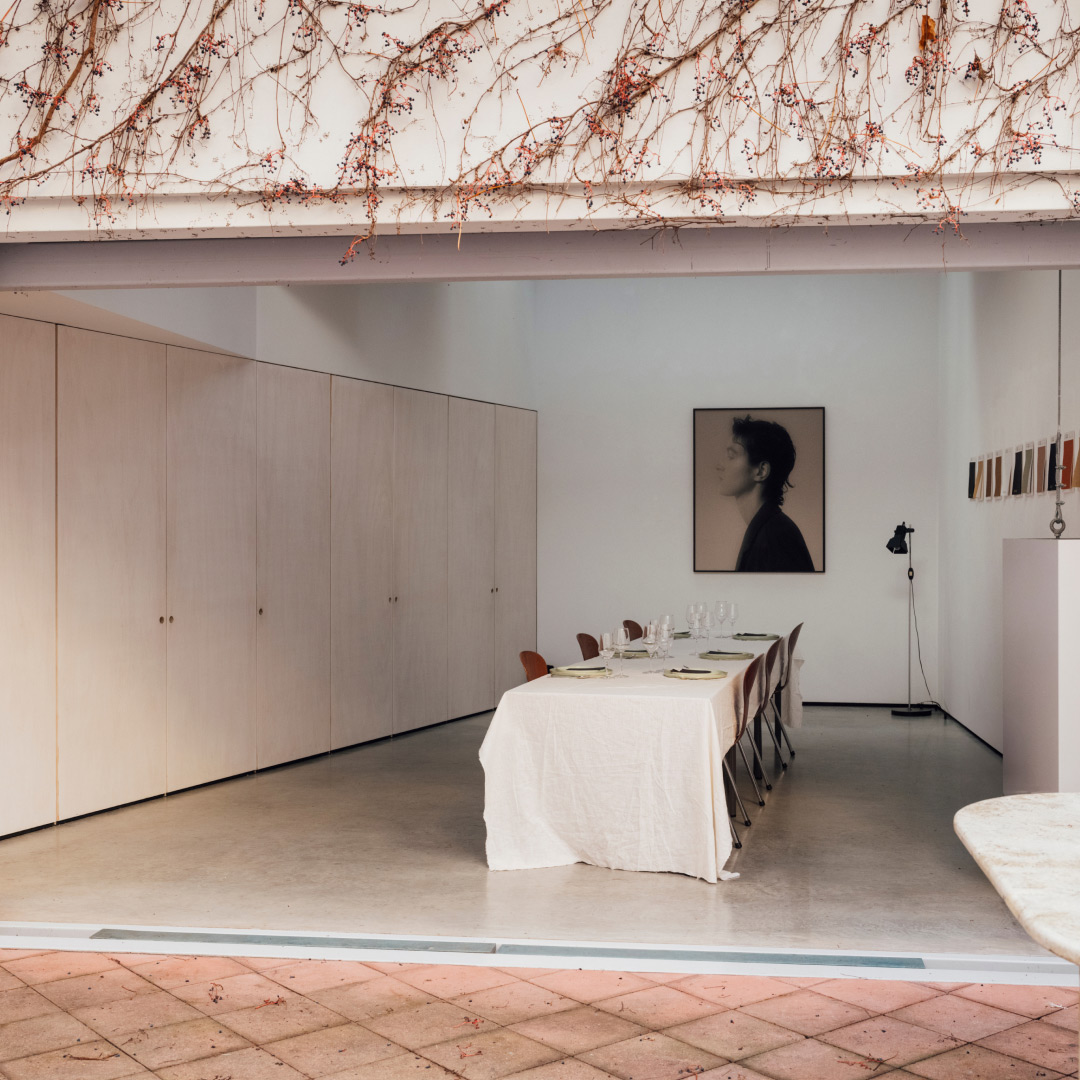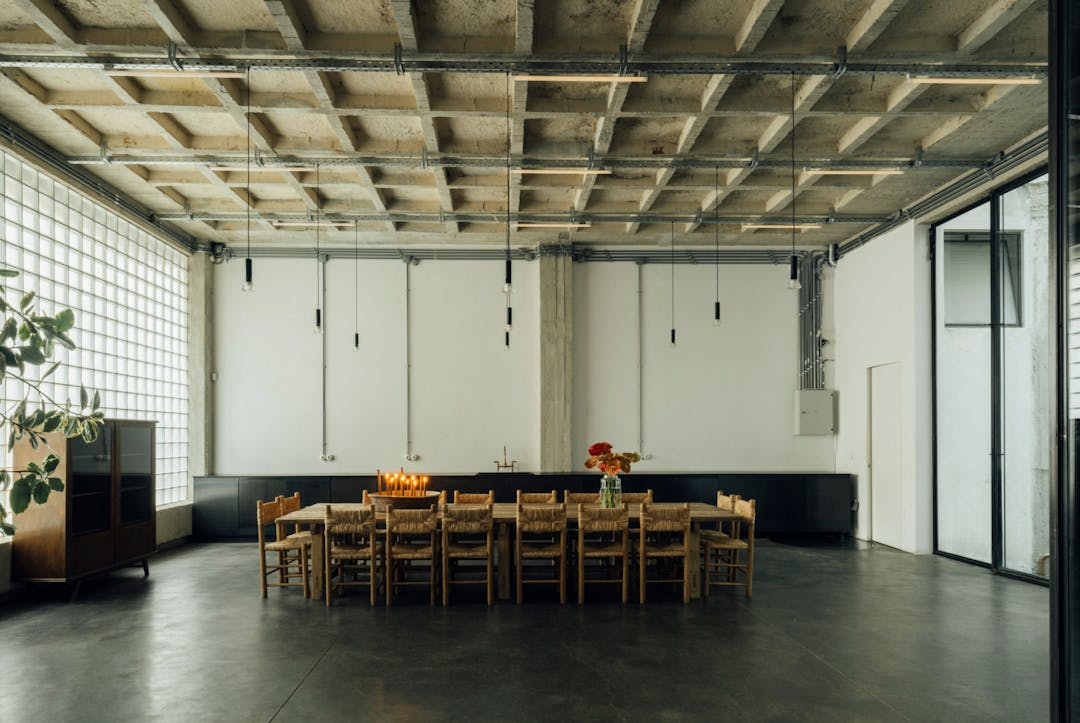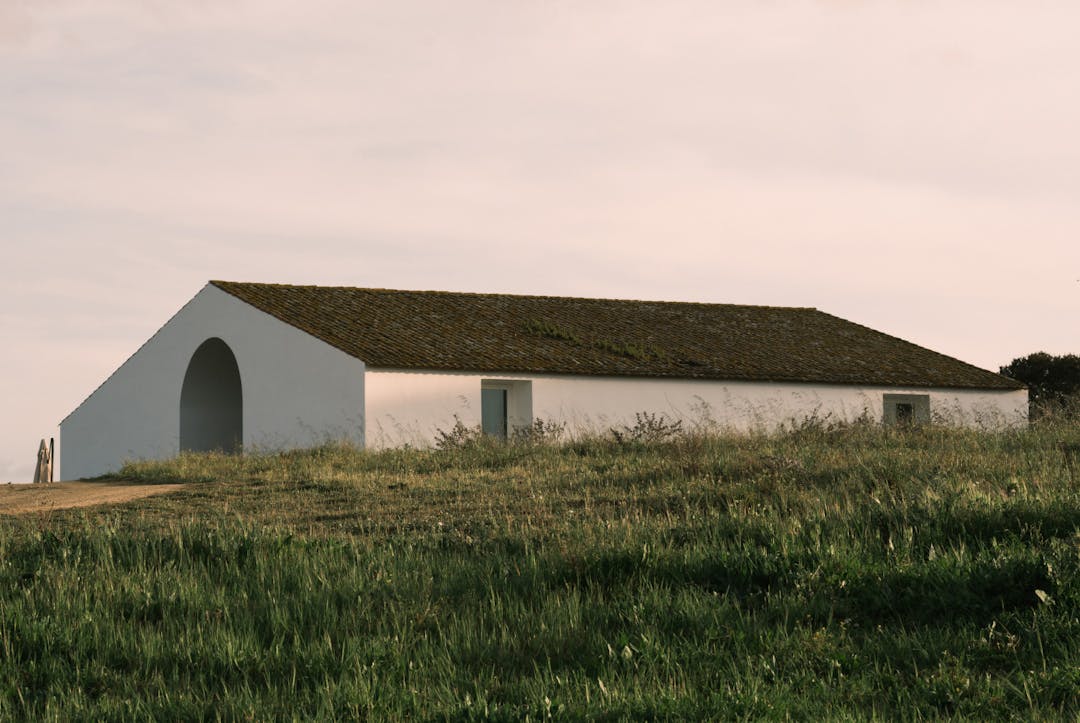
Play Movie

Listen
to Katherine Kennard
reading this story
ANTWERP’S HIDDEN SOUL
Patina Guesthouse
“Welcome to Belgium,” says Lies Mertens with a warm laugh, gesturing towards the grey skies and rain-soaked streets of Berchem, her Antwerp neighbourhood. Known for its dampness and for having the largest diamond district in the world, the Flemish city greets us this afternoon in typical fashion, and we feel happy to experience it as its true self. Having just arrived in this narrow, largely residential street, we are immediately struck by the intricate beauty and deep sense of history of this small port city, where art nouveau structures are intermingled with modernist postwar apartment blocks. Berchem, Lies later tells us, has become one of the most sought-after places to live in Antwerp, with more and more fine-dining restaurants and hip cafés popping up. Just a decade ago, it was a quiet, semi-industrial area on the fringes of the city, and far less desirable.



Our host stands in the doorway of her guesthouse, Patina. Tall and smiling, wearing a loose, full-length navy cotton jumpsuit that blurs the line between artisan workwear and cool, effortless style, paired with mid-heeled black leather boots, she exudes a gentle congeniality. Her bobbed blonde hair is swept back in a no-fuss ponytail. She ushers us through the wide frosted glass doors into the terracotta-tiled entrance hall, leading directly to a quiet inner courtyard. A simple black concierge desk denotes the entry to the guesthouse – but first, Lies leads us to her atelier on the left, a light-filled space with large windows where she creates prototypes and sketches out designs for her eponymous handbag label. A glimpse through the multi-paned windows reveals shells lining the sills, a sewing machine, a rainbow of leather swatches and notebooks atop work benches, handbag samples hanging from rails and a neat mood board featuring inspirational images, pencil drawings, objects from nature and more fabric pieces.
We continue across the rectangular courtyard, festooned with dangling vines that hang bare at this time of year, but in the warmer months bloom green like a mass of decorative bunting. On the other side lies the white-walled gallery space, with a frontal glass wall that can open completely, merging with the elements. Communal dinners are often hosted here, especially in summer and often in collaboration with friends from Antwerp’s culinary scene. One such event, Lies explains, featured an outdoor kitchen set-up by Nage, a local restaurant, with leather menu holders handcrafted by Lies, offering four courses for 24 guests. “I really like bringing people together,” she says, “to share the experience that you’re having at that moment.”


Lies also occasionally hosts art exhibitions in her gallery, showcasing pieces by artists such as the British painter Katie Tomlinson and Antwerp-based Sofie Marijnissen. Their works now adorn the bedrooms of the house, inviting guests into an intimate dialogue with contemporary art. “I want the guesthouse to feel like a home for art as much as for people,” Lies explains. “From every exhibition, one piece comes into the house; sometimes it is in exchange for the use of the space, sometimes I buy it.”
“It was love at first sight. A friend sent me a link to this house that was for sale, and when we walked in, I immediately felt its energy and potential.”
LIES MERTENS
The name of the guesthouse, Patina, is a tribute to Lies’s love of materials that age beautifully. “Whether it’s leather, wood or even stone, I’m drawn to how they change over time,” she explains. It’s a deeply personal project that is not just a space to stay but an experience steeped in stories and craftsmanship. As we follow her back across the courtyard to the door leading immediately up an old, narrow wooden staircase to the first floor, Lies reveals more about the story of Patina, and how it began serendipitously. “It was love at first sight,” she recalls. At the time, she was searching for a place where she could have a dedicated atelier to inspire creativity, separate from the administrative side of running a business. “A friend sent me a link to this house that was for sale, and when we walked in, I immediately felt its energy and potential.” By ‘we’ she is referring to her former partner, the designer and art director Vincent de Boeck, with whom she began this endeavour.




Built in the early 20th century, the house’s industrial past connected it to Antwerp’s bustling port. The previous owners had already converted parts of it into an art gallery and atelier space. The building’s walls seemed to whisper of creativity, collaboration and transformation. “The ground floor was probably an office space for a company linked to the harbour,” Lies explains. “A lot of houses in this area have back houses, with something extra hidden behind every façade.” Embracing the building’s layered history, she saw an opportunity to preserve its essence while making it her own. The renovation spanned two years, with Lies and Vincent doing most of the work, meticulously balancing respect for the past with Lies’s vision for the future. Every decision was intentional, driven by a commitment to sustainability and an appreciation for imperfection.




We now find ourselves in the first guest bedroom, a light, airy space that feels like a chic studio apartment. There’s a wide leather sofa behind the pillowy bed, above which hangs a vintage Anvia counterbalance lamp that the previous owners had left behind. Nearby is a green cast-iron plant stand made in collaboration with Lies’s friend and architect Camiel van Noten, nephew of fashion designer Dries van Noten. Other striking elements include a sculptural free-standing mirror by local interior architecture studio Venlettettelin, with whom Lies worked together on the design of the rooms, and who displayed the mirror and other objects in an exhibition here. A pristinely polished timber sideboard sits below an intriguing photographic artwork by Anne Decot, who runs the Lies Mertens flagship store in Antwerp city centre. Overall, the minimalist aesthetic and soft, neutral colour palette evoke a feeling of calm and surrender.


“Both rooms,” Lies points out, “have these clay walls, which is why you have more of a warm and acoustic sound.” We run our hands over the pleasingly earthy, tactile surface, connecting to the depth and grounding they bring to the space. “We did a workshop and rendered the walls ourselves, sourcing the clay from a Brussels-based company that recycles urban soil into building materials,” she continues. “Most of the furniture and materials are upcycled or second-hand – many are random vintage trouvailles that I’ve collected over the years, often in the Netherlands. For me, it’s important that things have a real story, that it’s not just a superficial aesthetic thing.” Even the door to the room reflects this philosophy, covered in a monotone pale-green leather patchwork crafted by Lies using offcuts from her bags and applied to the original transparent glass panel.
“I think what’s surprised me most as a hotelier is that if you really translate something of yourself into a room, you attract people who relate to that same vibe.”




Directly opposite is the shared dining room and kitchen. Lies offers to make tea – a delicious vanilla-scented Chinese milky oolong that she proclaims her current favourite, from the charming Mattheus-B tea and coffee shop in the city centre. We pause our tour and sit together at the oval vintage table, looking at a beige leather patchwork artwork on the wall, co-created by Lies and Vincent. “I love combining different materials to create something new,” Lies explains. Sipping from handcrafted mugs, we notice that the bottoms are stamped with ‘Patina’ – the result of another collaborative exchange. A glass door at the end of the room opens out onto a small balcony overlooking the courtyard and gallery. With a pair of abundantly leafy plants in one corner and a few weighty architecture and design tomes stacked on a shelf, it has a comforting, homely vibe. “I think what’s surprised me most as a hotelier is that if you really translate something of yourself into a room, you attract people who relate to that same vibe,” she says. “It draws in and connects like-minded people. A lot of people that stay here come from the creative scene. Some of my guests end up meeting by accident in this shared space and they start a conversation. I always really like to make people feel at home.”
We resume our tour. Lies leads the way up another flight of stairs to Patina’s second guest bedroom – a cosy, cream-carpeted cocoon. Crafted by her uncle, a retired woodworker, and upholstered in carpet to echo the room’s textured intimacy, a divinely minimalist 1970s-inspired sunken bed is the focal point here. The platform surrounding the bed continues along the windowed wall, morphing into a kind of chaise longue at the other end with a giant poofy leather cushion, handmade by Lies. Full bookshelves, a white leather Wassily armchair first designed by Marcel Breuer in 1925, and a 1960s round glass-and-metal table by Osvaldo Borsani for Tecno complete a supremely inviting setting. A strong desire to touch the surfaces and explore the space, then curl up quietly with a book washes over us. “The floor is completely covered in paint, because it was once used as an atelier room,” Lies tells us. “I thought it was a pity to remove all the paint, so we covered it with carpet instead. I wanted each piece to feel like it belonged, to make the space warm and grounded.”



Unlike the room on the first floor, with its ensuite bathroom, the second room has a spacious separate bathroom with a dramatic, heavy red curtain across the whole bath area. Lies playfully demonstrates how you can draw it closed and simply shut out the world when you need a break. There’s even a little shelf to place your laptop for watching a movie while you soak. Instead of the perhaps more obvious stark white, the bathroom design continues with a slightly retro theme in a skilfully tasteful, interesting way – again, drawing us in and inviting interaction. Next-door is Lies’s own bedroom for when she’s not at home in Brussels, where she mostly resides.
Later in the evening, after a delectable dinner at one of Berchem’s stylish neighbourhood bistros, we discover the bed in room one to be just as heavenly as it appeared earlier. There’s very little noise from the street outside and we easily drift into a restful slumber. In the morning, bustling sounds coming from the kitchen gently rouse us, and we slowly prepare for the day, happily padding about in this warm, comfortable environment, making use of the large rain shower in the open ensuite bathroom. When we emerge, ready, we discover breakfast options thoughtfully laid out on the table in the dining-room across the landing, including fresh fruit and granola with Belgian chocolate.
“My dad died when I was seven. I think that kind of shaped me. It was just my mum and I – and my cat. I think that made me learn to do a lot of things on my own, to be more creative. I am much more daring, perhaps, because of the challenges that I faced when I was young.”

“Good morning, how did you sleep?” Lies cheerfully inquires, coming up the stairs and offering us a cup of coffee. Dressed today in a loose shirt and trouser ensemble in a rich dark-brown shade, with the same black boots, hair brushed out, she looks fresh and put together, ready for our photoshoot. She lingers for a friendly chat. “I hardly ever wear makeup, it’s just not me,” she modestly admits, smiling, “so I got up early to have plenty of time to apply it.” A large, sweet-looking ginger cat saunters into the room, meowing loudly to greet us. Lies bends down to pick him up, his rotund softness filling her arms. He purrs and nuzzles her. “This is Snorreke,” she says, introducing us. I ask if his name means something. “It’s Dutch for ‘tiny moustache’. He was staying nearby with my partner, but he’s just been dropped back. He’s very friendly and loves attention.”

Later in the day, as Lies moves through the rooms, smoothing beds, plumping cushions and generally prepping the house – Snorreke always close by – she talks of her childhood growing up in a very small town in Flanders. Her mother worked as a nurse and her father at the local newspaper. Tragically, her father was diagnosed with cancer when Lies was just three years old. “My dad died when I was seven. I think that kind of shaped me,” she says, reflectively. “It was just my mum and I – and my cat. I think that made me learn to do a lot of things on my own, to be more creative. I am much more daring, perhaps, because of the challenges that I faced when I was young.” Being in her presence, we certainly feel as though we are in capable, caring hands, that as guests, we will be looked after and that no request would be too big or too small for her to amenably accommodate. We sense a wiseness beyond her years.
Lies’s path to Patina was winding. Studies in graphic design, cultural studies and fashion management, combined with stints in Paris and Reykjavik, along with an enduring love for Scandinavian landscapes, informed her aesthetic. “I’m inspired by clean lines, natural colours and textures that evoke a sense of place,” she says. “I’m also interested in a lot of things, and when I’m interested I want to know more about them, to understand them.” This has manifested in her taking evening classes in various subjects, including leather craft, simply to deepen her knowledge.
“With Patina, there was no pressure, there was no one waiting for something. There was all the time in the world to think, ‘Oh, let’s do this,’ or ‘Let’s do that,’ and it was a way better translation of myself.”
The Lies Mertens handbag label was founded in 2017. It all began quite unintentionally, Lies explains, after she started designing and crafting leather bags just for herself. When she wore them, she had so many inquiries from friends and strangers that it inspired her to take it further. Based on the philosophy of creating timeless, long-lasting and functional pieces for everyday use, the brand then grew unexpectedly fast. So much so that, a few years later, Lies began to feel as if she was losing herself in the process; that she was so busy dealing with the business side of things that her creativity was compromised. She credits her guesthouse with helping her reconnect with her roots and make some essential changes. It allowed her to slow down and refocus by separating her creative space from her office and creating a tabula rasa for fresh ideas and opportunities. “With Patina, there was no pressure, there was no one waiting for something,” she says, gesticulating away the stress. “There was all the time in the world to think, ‘Oh, let’s do this,’ or ‘Let’s do that,’ and it was a way better translation of myself. That helped me see that that element was gone in my own label. It didn’t represent me anymore.” So, in 2024, about a year after opening Patina, she halved her team and closed her second store, in Brussels, and found her way back to the core of it all, right where she needed to be.

Quietly self-assured, calm and content, Lies seems to have found her footing, radiating a positive energy and ceaseless curiosity that are no doubt taking her into her next phase of developing Patina further. She has achieved what many dream of: a space that is both profoundly personal and universally welcoming. In Patina, she has crafted not just a guesthouse, but a home imbued with soul – a place where every scratch, every story and every shared moment adds to its enduring allure.



